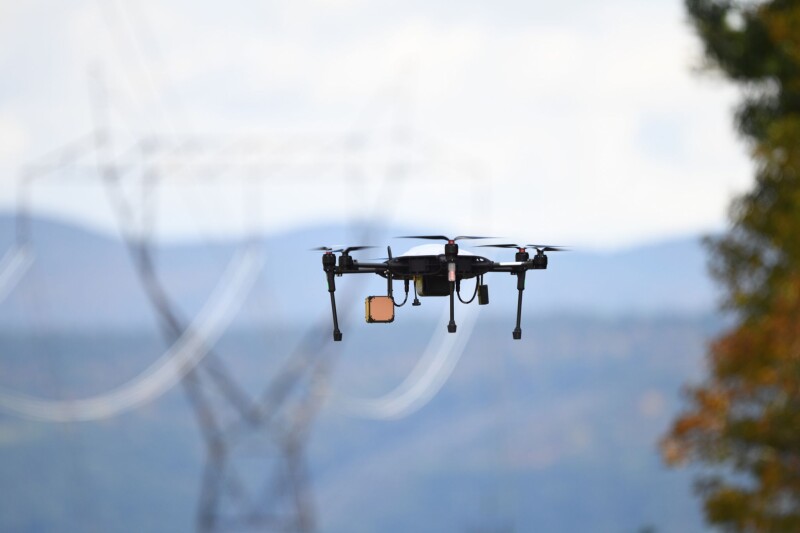Manifold Robotics proudly announces the successful culmination of a product development effort performed in collaboration with the New York Power Authority (NYPA) focused on increasing the safety and efficiency of  Unmanned Aircraft System (UAS)-based electric transmission infrastructure inspections. The project, which launched in 2020 with partial funding from the New York State Energy Research and Development Authority (NYSERDA), developed new sensing technologies and software algorithms to enable UASs to leverage the electromagnetic fields (EMF) emitted by power transmission lines for navigation.
Unmanned Aircraft System (UAS)-based electric transmission infrastructure inspections. The project, which launched in 2020 with partial funding from the New York State Energy Research and Development Authority (NYSERDA), developed new sensing technologies and software algorithms to enable UASs to leverage the electromagnetic fields (EMF) emitted by power transmission lines for navigation.
UASs are becoming an indispensable tool for performing infrastructure inspections. However, flying UASs near and around transmission lines is uniquely challenging. Remote pilots often find it difficult to visually judge the distance between the UAS and the transmission line conductors, and flying along transmission lines poses similar challenges, in addition to coping with regulatory constraints for beyond visual line of sight (BVLOS) flight.
To address these challenges, Manifold Robotics and NYPA collaborated to develop an EMF sensing system for UASs. By sensing the EMF emitted by transmission lines, UASs can detect the presence of lines and estimate their distance to them – opening the door to automated collision avoidance or line tracking. The product development effort required the design and fabrication of electric and magnetic field sensors with ample sensitivity while also contending with size and weight constraints of small UASs. Software algorithms were developed to analyze the EMF data in flight and issue commands to the UAS to either avoid collisions with the line or autonomously track along it.
“The Power Authority sees great potential in technology that enables automated flights and can more safely navigate our critical transmission infrastructure during inspections,” said Alan Ettlinger, NYPA’s senior director of Research, Technology Development and Innovation. “Collaborating with Manifold Robotics will allow our transmission line inspection programs to benefit from the latest commercial drone developments while also building on our track record of innovation in this rapidly evolving clean energy landscape.”
More than 100 test flights were performed with the technology on NYPA’s transmission line infrastructure. As a final demonstration, the technology was deployed for an approximately one-mile-long flight along a 345-kV line. The EMF sensing technology guided the UAS to maintain a 20-foot standoff distance from the line while flying parallel to it. In doing so, the UAS autonomously followed a change in the transmission line direction, as well as adjusted its altitude to account for varying conductor height due to line sag and terrain variation.
“This technology does not rely on GPS waypoints for flying along transmission lines, but instead directly estimates its distance from the line,” said Jeffrey Laut, CEO at Manifold Robotics. “This approach is expected to provide a compelling advantage for beyond visual line of sight flight along transmission lines for inspection purposes as it enables UASs to safely fly in close proximity to the lines where the risk of encountering other aircraft is insignificant — a concept known as obstruction shielding.”
Doreen M. Harris, President and CEO, NYSERDA said, “As we move toward a zero emission electricity system and bring more renewable energy projects online, it is more important than ever for grid operators to quickly and safely deploy equipment necessary to evaluate the infrastructure delivering clean energy to New Yorkers. Through NYSERDA’s support for innovative new technologies like Manifold Robotics’ unmanned aircraft system, we can capture the data needed to inform decisions that will enhance the reliability and resiliency of critical transmission lines.”
Manifold Robotics was recently granted a BVLOS waiver from the Federal Aviation Administration (FAA) on the basis of the developed EMF technology, allowing the UASs to fly greater distances along NYPA’s transmission lines than normally permitted under Part 107 regulations, which govern commercial UAS use and requires visual observation of the UAS. This waiver approval solidifies the technology’s value in enabling longer-range UAS flight for inspection purposes through the use of obstruction shielded operations.
Funding for this project was provided by NYPA and NYSERDA through its Electric Power Transmission and Distribution High Performing Grid Program, which makes investments in research and development that accelerate the realization of an advanced, digitally enhanced and dynamically managed electric grid.
Source: Manifold Robotics
















Comments